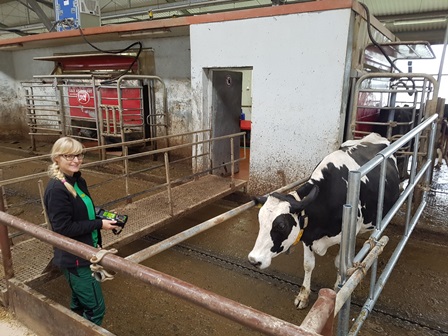 Large-scale methane measurements on individual ruminants for genetic evaluations
Large-scale methane measurements on individual ruminants for genetic evaluations
COST METHAGENE STSM Blog of Diana Sorg
I am a postdoctoral scientist with Prof. Hermann Swalve from the Animal Breeding group of Martin Luther University Halle-Wittenberg in Germany. We measure methane emissions from dairy cows with the mobile, non-invasive, hand-held Laser Methane Detector (LMD). It records the methane concentration in the air along the laser path between the cow’s mouth and the device. In our research project we want to identify possible methane phenotypes for the genetic selection of dairy cows that can be measured with the LMD under commercial conditions. Since the start of the project 1.5 years ago I have gathered some good experience with the LMD, but now I wanted to know more about how this technique relates to other methane measurements that can be applied in a dairy barn.Thanks to the support of the METHAGENE COST Action for an STSM I was able to take this handy device with me and visit Dr. Marcin Pszczola at Poznan University of Life Sciences in Poland for one week in June 2016. We wanted to compare our LMD to the FTIR ‘sniffer’ which was installed in the feeding bins in automatic milking systems (AMS) at a dairy farm cooperating with Poznan University of Life Sciences. In the AMS cows are milked by an automatic milking unit while eating concentrate from a feed bin. In this feed bin a plastic tube is constantly sampling the air exhaled by the cows. The air is then transported to an analyzer unit (as seen in blue on the picture) where the concentration of methane is measured. With this setup, every cow gets measured each time she is milked, several times a day.
During my stay at the farm I took LMD profiles of the cows leaving the AMS, so that we had corresponding FTIR and LMD profiles that were recorded immediately after each other. The cooperation with the scientists from Poznan University was really productive and everyone was very helpful. The farm staff even offered to build an improvised pen from scratch, so that I could keep the cows there for my LMD measurements!
I hope that our data will contribute to a joint publication after we will have analyzed them together. We also want to establish a continuing exchange of knowledge between our two groups and visit each other again in the future.
Dr. Diana Sorg
diana.sorg@landw.uni-halle.de



